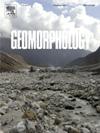喜马拉雅中部LGM时期山前冰川作用下的气候模式
IF 3.1
2区 地球科学
Q2 GEOGRAPHY, PHYSICAL
引用次数: 0
摘要
第四纪冰川是重建青藏高原古环境和古气候的重要指标。然而,观测资料的稀缺和分布不均阻碍了我们在区域尺度上理解冰川与气候变化之间的相互作用。本文采用实地考察和冰川模拟相结合的方法,探讨了喜马拉雅中部末次盛冰期(LGM)山前冰川的进退过程。6座冰碛的30个10Be暴露年龄表明,中喜马拉雅北坡山前冰川在17.4±2.6 ka ~ 19.6±1.2 ka期间发生了广泛的推进。然后,利用二维冰流-质量平衡耦合模型重建冰川范围、冰厚和平衡线高度(ELA)。模拟结果与我们的年代冰碛和先前发表的观测结果吻合良好,证实了LGM期间喜马拉雅中部冰川面积约为现代冰川面积的11.6倍,面积和体积分别为9985 km2和1885 km2。LGM期间的区域平均ELAs为5293±218 m,比现在低347±110 m。受区域地形、地质和大气环流的影响,喜马拉雅中部古ela在南侧(5190±220 m)较低,在北侧(5348±195 m)较高。由于山脉朝向和地形影响的差异,中部地区海拔高度(4850±268 m)比西部地区(4935±334 m)低85±66 m,比东部地区(5008±255 m)低185±13 m。该研究为大尺度区域古环境和古冰川重建提供了框架,有助于理解冰川波动的异质性。本文章由计算机程序翻译,如有差异,请以英文原文为准。
Climate patterns derived from piedmont glaciation during the LGM in the Central Himalaya
Quaternary glaciers serve as vital proxies for reconstructing the palaeoenvironment and palaeoclimate on the Tibetan Plateau (TP). However, the scarcity and unevenly distributed observations impede our understanding of the interactions between glacier and climate changes at a regional scale. In this study, we explored the advance and retreat of the piedmont glaciers during the Last Glacial Maximum (LGM) in Central Himalaya, using a combination of field investigation and glacier modelling. The thirty 10Be exposure ages from six moraines shows the piedmont glaciers in the north slope of the Central Himalaya occurred extensive advance during 17.4 ± 2.6 ka to 19.6 ± 1.2 ka. Then, glacier extents, ice thickness, and equilibrium line altitude (ELA) were reconstructed using a 2D coupled ice-flow and mass balance model. The modelling results were well-matched with our dated moraines and previously published observations, confirming that the glacier area in the Central Himalaya during the LGM was approximately 11.6 times larger than that of modern glaciers, with the area and volume of 9985 km2 and 1885 km3. The regional average ELAs during the LGM was 5293 ± 218 m, about 347 ± 110 m lower than the present. The palaeo-ELAs were lower on the southern side (5190 ± 220 m) but higher on the northern side (5348 ± 195 m) of Central Himalaya influenced by regional topography, geology, and atmospheric circulations. The ELAs in the central region (4850 ± 268 m) were 85 ± 66 m lower than at the western Gurla Mandhata (4935 ± 334 m) and 185 ± 13 m lower than at the eastern Mansell Snow Mountains (5008 ± 255 m) due to differences in mountain range orientation and orographic effects. This study provides a framework for large-scale regional palaeoenvironment and palaeoglacier reconstructions and contributes to understanding the heterogeneity in glacier fluctuations.
求助全文
通过发布文献求助,成功后即可免费获取论文全文。
去求助
来源期刊

Geomorphology
地学-地球科学综合
CiteScore
8.00
自引率
10.30%
发文量
309
审稿时长
3.4 months
期刊介绍:
Our journal''s scope includes geomorphic themes of: tectonics and regional structure; glacial processes and landforms; fluvial sequences, Quaternary environmental change and dating; fluvial processes and landforms; mass movement, slopes and periglacial processes; hillslopes and soil erosion; weathering, karst and soils; aeolian processes and landforms, coastal dunes and arid environments; coastal and marine processes, estuaries and lakes; modelling, theoretical and quantitative geomorphology; DEM, GIS and remote sensing methods and applications; hazards, applied and planetary geomorphology; and volcanics.
 求助内容:
求助内容: 应助结果提醒方式:
应助结果提醒方式:


